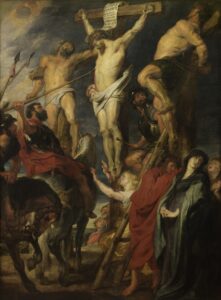Peter Paul Rubens and Anthony van Dyck: The Lance Sting
Proceed to Room 2.2 (Rubens’ room)
As a residence and museum we speak of the Rubens House, as a studio House of Rubens & Associates might sound better. Who actually painted what?
In the 1988 catalogue of the Fine Arts Museum, this painting is called ‘Christ crucified between two criminals’, but is widely known as ‘Coup de Lance/The Lance Sting‘. In room 2.2 of the museum, the sign now reads ‘Anthony Van Dyck in the studio of Peter Paul Rubens’. Until recently it was assumed that Rubens had been the sole painter of this work.
The client for the painting was Antwerp mayor and maecenas Nicolaas Rockox. He had commissioned it for the high altar of the Church of the Friars Minor (today: the Arts Academy, Mutsaardstraat), around 1619-1620.
Shortly after this assignment, Rubens himself took on the major project of ceiling paintings in the church of St. Charles Borromeo, then: St. Ignatius. Here the contract with the Jesuits explicitly mentions the name of Anthony van Dyck.
Can we accept the notion of a cooperative undertaking? Today, do we only remember the name of the director of a film? What about the scenario writer, or the producer?
The painting is evidence of Rubens’s forceful imagination. The scene focuses on the ‘Coup de Lance’ of the centurion, who wanted to check whether the Crucified was really dead. So, he pierces the side of the pale body with his spear; and “immediately blood and water gushed out” (John, 19:34). We see Mary Magdalene, who protests against this senseless violence; and we notice John and Mary who don’t want to look at this additional injury. The painting also shows that the legs of the other convicts are broken to speed up the dying process. Their curved bodies are in contrast with the straight lines of crosses, lances, ladder and the legs of the horses; only Jesus is completely motionless. The alleged solar eclipse is coming to an end and a bit of light pierces through the cloudy sky.
The spectators, who are standing lower on Mount Calvary, provide perspective. They are somewhat blurred, perhaps with intent: these are the characters whom the viewer can identify with.
A scientific approach, with microscope, X-rays, infrared light, enables us to identify the handwriting of the individual painters, master and pupils, but that was not what the painters were after.
We’ll come back to this work at three other places on our route: at the Academy on Mutsaardstraat, at St. Paul’s Church, with ‘Death on the Cross’ by Jordaens and at the Cathedral of Our Lady with ‘The Raising of the Cross‘ by Rubens.
Proceed to room 2.11 ⇒ Elisabeth in concert

